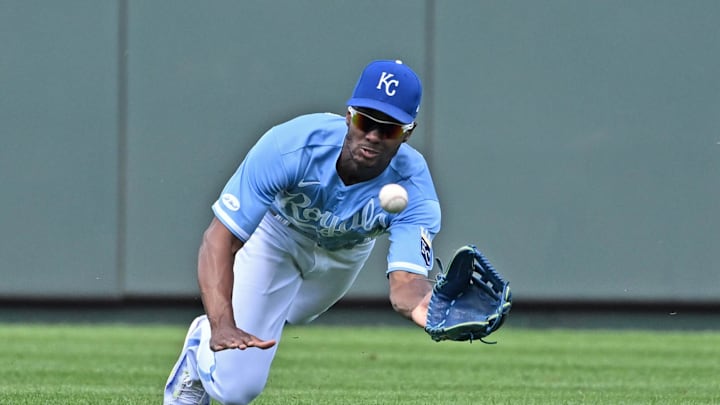No Silver Sluggers will ever adorn Michal A. Taylor's trophy case, but he's given the KC Royals two decent years since they signed him as a free agent after the 2020 campaign ended. The Gold Glove he won in his first Royal season and his stabilization of the club's shaky center field situation are two big reasons he's been good for Kansas City.
The Royals have proved their respect for Taylor twice, first when they discounted the .196 he hit for Washington in 2020, and his then-career .237 average, to bring his defensive skills to the spacious Kauffman Stadium outfield, and again when they signed him for another two years before the 2021 campaign was even over.
Now, though, there will be no second extension for Taylor. He'll turn 32, an age not well-matched with the club's shift toward youth, four days before Kansas City and Minnesota launch the 2023 season at Kauffman Stadium, and the presence of Edward Olivares, Drew Waters, Kyle Isbel (and perhaps even minor leaguer Tyler Gentry), necessarily number Taylor's days as a Royal. And the club surely prefers more offensive production than Taylor provides.
So it is that the Royals need to move Taylor, hopefully sooner rather than later.
The KC Royals should trade Michael A. Taylor at the first good opportunity.
Cause for the Royals to move Taylor expeditiously lies primarily in the need to timely test their younger outfielders' suitability for the design general manager J.J. Picollo has in mind for his club. Playing Taylor in center field every day gives manager Matt Quatraro far fewer opportunities to see what Waters et. al. can do.
That's one reason trading Taylor as soon as possible makes so much sense. Spring training begins in mid-February, so moving him before KC opens its Cactus League schedule Feb. 24 gives Quatraro and Picollo over a month to look over potential active roster outfielders before the regular season starts. Waters, then, who impressed in the 32 games he played for the Royals after they acquired him in a July trade with Atlanta and seems the likeliest player to succeed Taylor, can get plenty of time in Arizona, and then early in the regular campaign, to prove his worthiness for the center field job.
The same goes for Olivares and Isbel, but for slightly different reasons. Isbel's 2022 was a disappointment, but his good 2021 major league debut campaign and speed give the Royals reason to believe he, too, can play center and, importantly, reason not to give up on him anytime soon. A Taylor trade means he can see more action.
This season will be Olivares' fourth with the Royals, meaning it's probably a make-or-break year for him; although he's not generally considered a center fielder, opening up that position by dealing Taylor should give him more opportunities to play in right (and maybe left) if Waters and Isbel focus on center.
What Kansas City might get for Taylor is purely speculative, but a market surely exists for a proven Gold Glove outfielder whose 2023 contract requires whoever he works for to pay him only $4.5 million, and some $50,000 incentive payments if he qualifies for them, this season. And trading him now, rather than at the midsummer trade deadline, could reap a better return.
Can the Royals find a trade for Taylor soon? Time will tell.
Kansas City should find a deal for Michael A. Taylor.
